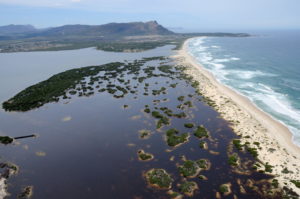
The theme for World Wetland Day 2 February,2022 is “Wetland action for people and nature”.
Wetlands contain the most diverse number of vegetative species in the world. The United Nations biodiversity framework is currently being developed and focusses mainly on wetlands. This framework looks at how to preserve or increase biodiversity in our world. COP 26 was not just a academic exercise – climate change affects us all in our daily lives.
The idea of the UN program is to protect peatlands and wetlands to achieve zero emission (no increase in carbon emissions) by 2050 – 28 years away.

The Bot River Estuary is a declared RAMSAR Heritage site, protected from the 1971 convection signed in Ramsar, Iran by most of the world. The Estuary is surrounded by many wetlands which have unfortunately been allowed to deteriorate. What were once open water bodies in Hawston and between Fisherhaven and Hawston are now overgrown with reeds and alien plant species, never mind the buried or destroyed wetlands.
Over 35% of global wetlands have been lost in the last 50 years, and Ward 8 is right up there. Over 40% of world species live and breed in wetlands. Wetlands and peatlands store twice as much carbon as all the forests combined. At present we have too much carbon emitted into the atmosphere – promoting climate change.
Around the Bot River Estuary some areas have been reduced from 400-500 species, to having as little as 5-10 species of plant and animals due to invasive plant species. Now, some wetlands are completely overgrown with Port Jacksons, which use up all the water and dry out the wetland. The wetlands were also natural barriers to fire. As a result, the fire risk is now so much higher from the extra biomass and much more flammable Port Jacksons than when there were only balanced indigenous species, adapted to fire. This extra biomass considerably reduces the quality and quantity of clean water entering the Estuary. It also allows more silt into the estuary (pollution) and promotes massive biodiversity loss. There is a hugely increased fire risk to infrastructure (your houses and businesses) and little or no carbon is being stored anymore.
In fact, the wetland areas are now a carbon exporter to the atmosphere (with more frequent fires) rather than encouraging the storage of carbon by looking after our wetlands.
The decrease in the value of our wetlands and environment in general is making a considerable contribution to climate change. Most of this has not become irreversible yet and we can still save our environment and lovely estuary if we lobby for wetlands to be restored to their “former glory”.
Do your thing for world wetland day. Watch the you-tube video World Wetlands Day 2022: Wetlands Action for People & Nature – YouTube. Produced by the Secretary General, RAMSAR, Martha Rojas Urrego.
Michael Austin

Recent Comments